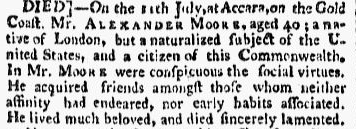The will of my 4th great-grandfather Walter Sprott, who died in 1844, included a very lengthy list of property:
My real estates situate and
being at Crowborough Common in the Parish of Rotherfield in the County of Sussex and now in the several tenures or
occupations of William Farris and Thomas Izzard yeoman
My freeholds messuages or
tenements and the gardens thereto
belonging situate and being on Cumberland Cottage at Tunbridge Wells aforesaid
and known by the name of Marine House the cottage behind the same and Marine Cottage
My freehold accoutraments and
premises at New Romney in the County of Kent
My freehold cottages or
tenements and gardens to the same severally belonging situate and being in the
Parish of Lamberhurst in the County of Kent and now in the holding of Stephan
Goad and others as my tenants
The leaseholds messuage or tenement
at Tunbridge Wells in which I now reside together with the several pieces or
parcels of meadowlands and the roadhouse stable and coach house to the same
belonging and held by me under a lease from the late honourable Catherine
Scovill the honourable George Henry Scovill and the late Earl of Abergavenny
My freehold Cottage situate at Beeding in the County of
Sussex unto my said wife Mary Sprott absolutely I give to my said wife all that
the annuity or clear yearly sum of ten pounds per annum to which I am entitled
during the life of Mrs. Sarkin
For her own use I give her four
leasehold cottages at Tullys Village in the Parish of Frant now in several occupations of [blank] Cushman and
others
Also all those my four leasehold
cottages situated at Pembury in the County of Kent which I sold under lease
from the late Marquis of Camden unto and equally between my said wife and my
said daughter Sophia Sprott their respective executors administrators and
assigns
I give and devise all that my
freehold messuage or tenement farm lands hereditaments and previous situate and
being in the Parish of Brenchley in the County of Kent and now in the tenure or
occupation of George Bull Yeoman
Also all that my freehold farm
and lands situate and being in the Parish of Tonbridge in the said County of
Kent and now in the occupation of Richard Twort Yeoman
Also all that my cottage or
tenement and the piece or parcel of meadow land thereto belonging to Richard
Strange but now in the tenure or occupation of Thomas Skinner Esquire
Also all that freehold estate
situate and being at Tunbridge Wells aforesaid and known by the name of the
Chapel House Estate and the piece or parcel of ground thereto belonging and
which is reserved for the erection of one or more Villa or Villas and the
necessary appendages to the same
Also my two fifth parts or
shares of and in a certain freehold estate situate and being on Mount Ephraim
at Tunbridge Wells aforesaid and lately divided between the other proprietors
and me by a Deed of Partition and which said two fifths parts or shares
comprise two pieces of land so allotted and awarded to me for my share in the
said estate are adapted as sites for building one or more Villa or Villas and
the necessary appendages for the same
Also all those several pieces or
parcels of freehold land containing by admeasurement seven acres two roods and
twenty two perches situate and being at or near Dorset Green in the Parish of
Speldhurst in the County of Kent aforesaid together with right of common to the
same belonging and within the freehold manor of Rusthall and which in or about
the year one thousand eight hundred and sixteen or the following year I agreed
to purchase of Thomas Skinner of Tonbridge and the other three proprietors of
the same and was then put into possession and in receipt of the rents and in
the quiet and peaceable possession and in receipt of the rents and profits
thereof
Also all that my freehold
messuage or tenement and garden with the roadhouse and stable and the freehold land
and also the piece or parcel of copyhold land containing two acres or
thereabouts to the same belonging and which piece of copyhold land is holder of
the Manor of Frant in the County of
Sussex and which is intermixed with the said freehold land and contain
together six acres or thereabouts and said messuage land and premises are now
in the holding of Robert Gebben Esquire











